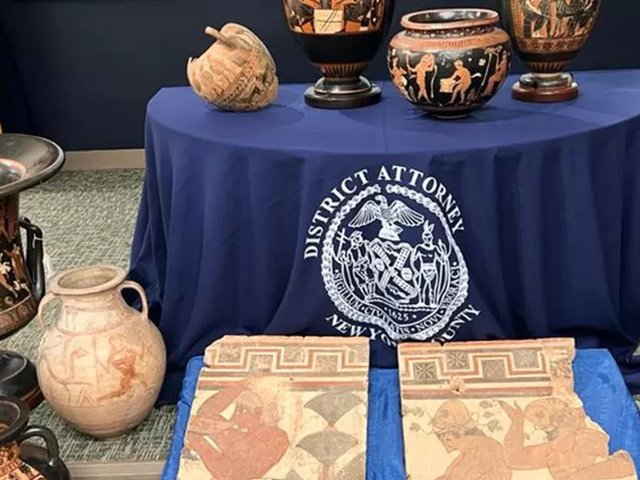An Italian archaeologist and antiquities expert says that a “substantial portion” of looted items returned to Italy earlier this year from the US are forgeries. Gianfranco Adornato, a professor of Greek and Roman art and archaeology at the Scuola Normale Superiore in Pisa, says that a high percentage of the 60 works, valued collectively at more than $20m, is “made up of easily recognisable fakes… these supposed works will hopefully never be exhibited in Italian museums”.
The 60 archaeological artefacts reportedly looted from sites around Italy—including a fresco taken from Herculaneum and bronze busts—were repatriated in January with much fanfare. Some of the objects were purchased by the billionaire collector Michael Steinhardt, while more than 20 items were also in the collection of the Metropolitan Museum of Art in New York, including a marble Head of Athena, dating from 200BC.
The objects, handed over by US officials to their Italian colleagues in New York in September last year, were repatriated thanks to an international trafficking investigation led by the Manhattan District Attorney’s Office and the cultural patrimony unit of the Carabinieri, Italy’s national police.

A Greek drinking cup, alleged to have been created in the sixth century BC, depicts two sphinxes in the wrong pose Carabinieri for the Protection of Cultural Heritage (TPC)
“This unit has been particularly effective; remarkable objects and monuments, part of Italy’s cultural heritage, have been recovered from major international museums, especially in the United States,” writes Adornato in our sister paper, Il Giornale dell’Arte.
Most of the works have gone on show in Rome’s Museum of Rescued Art (Museo dell’Arte Salvata) which opened last year in a space at the ancient Baths of Diocletian. Adornato says, however, that several items may be forgeries, including an amphora from the Greek Nicosthenic workshop (530BC-500BC) and an “eye cup” with a mask of Dionysus in the centre (500BC).
“We can note that the eye cup features a strange pattern of the eyes; it is devoid of tear caruncles, which are characteristic of this typology. Even the Dionysian mask [featured] is simplified with cursory and imprecise engravings. Another Attic band-cup, adorned with sphinxes on its sides, dating from the second half of the sixth century BC, presents the two monsters in a totally wrong pose, never witnessed in Greek art,” Adornato says.
He also singles out a dinos—a Greek mixing bowl—featuring a series of horsemen. “Although it imitates metal prototypes, this vase has a particularly squat support that is not found in other comparable vases. Furthermore, from a technical point of view, the forger exaggerates the horse’s mane, neck and ribs: the caparison [cloth covering] on the horse’s back is never represented in ancient art.” The Italian authorities have not revealed the collections that housed these items in the US.
Adornato tells The Art Newspaper: “I suspect other forgeries among the objects; not only the pottery—easily recognisable thanks to the iconography—but also some sculptures do not look genuine. We should look at them more closely as the surfaces were smoothed by acids and the incrustations look artificial.” The cultural patrimony unit of the Carabinieri did not respond to a request for comment.






